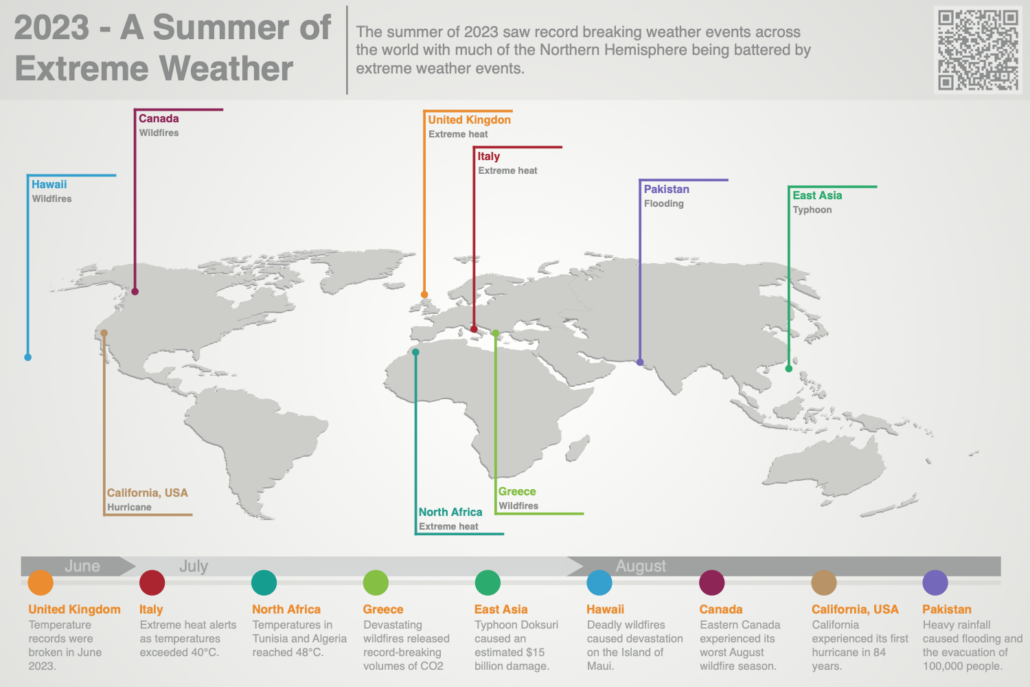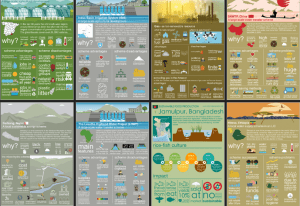Extreme weather, including raging wildfires, heavy rainfall, and intense storms, has marked this summer in the northern hemisphere. While not all incidents are directly linked to climate change, many records were shattered, raising concerns among climate scientists.
Let’s look at what happened during the summer and its link to climate change.
The UK experienced its warmest June, with a mean temperature of 15.8°C, surpassing the previous record by 0.9°C. Out of 97 monitored areas, 72 recorded their highest temperatures. According to the Met Office, climate change doubled the odds of such temperatures.
74% of monitored areas in the UK experienced record-breaking temperatures
In July’s first week, global average mean temperatures reached an unprecedented 17.23°C, beating the 2016 record of 16.92°C. Extreme heatwaves, named Cerberus and Caronte after figures from Greek mythology, affected millions in the Mediterranean.
Italy witnessed cities under extreme heat alerts, with Rome seeing temperatures exceeding 40°C. Famous attractions like Athens’ Acropolis closed due to the heat, and North African countries such as Tunisia and Algeria recorded temperatures up to 48°C.
The hot conditions led to devastating wildfires in the Mediterranean. Specifically, Greece’s July fires released a carbon footprint equivalent to two weeks of emissions from a major city like London. This is more than any other wildfire in July in any country.
1 megatonne of CO2e emitted from Greek wildfires.
Research from the World Weather Attribution suggested these heatwaves were nearly impossible without human-induced climate change, making heatwaves in southern Europe even hotter by 2.5°C.
El Niño is a climate phenomenon characterised by warming sea surface temperatures in the central and eastern tropical Pacific Ocean, often impacting global weather patterns. El Niño events typically occur every two to seven years. However, the intensity and specific impacts can vary with each occurrence.
Adding to the intensity, the El Niño effect began in June, indicating that 2023 might be the warmest year. Following the heat, late July witnessed severe rainfall and winds in East Asia. Typhoon Doksuri caused extensive damage in China and the Philippines, resulting in significant economic losses and over a million evacuations.
It is estimated that the cost of Typhoon Doksuri is $15 billion.
In the Philippines, 26 people died when strong winds caused a ferry to capsize in strong winds.
In the months leading up to the typhoons, many countries in East Asia experienced record heat.
According to scientists climate change made the July heatwave in China 50 times more likely.
August saw Hawaii’s Maui Island grappling with deadly fires exacerbated by drought and powerful winds. People living in the coastal town of Lahaina claimed early warning sirens did not work, with some people fleeing to the ocean to save themselves from the flames.
388 people are dead or missing on Maui
Strong winds from a passing hurricane fanned the flames.
It is not clear the impact of climate change on this catastrophe due to changes in land management in Maui.
Meanwhile, Canada faced its worst wildfire season in August, with over 15.6 million hectares burned in eastern Canada in the province of Columbia. At 15.6 million hectares, an area larger than England was burned. Canada has experienced its worst wildfire season in history. Human activity and climate change create fire-prone conditions, with climate change predicted to intensify wildfires.
In August, California is usually preparing for wildfires. However, it encountered its first tropical storm in 84 years in August. Storm Hilary led to power outages and flash floods. The storm placed 26 million people at risk of flooding, and 25,000 households lost power. Meanwhile, hotter oceans potentially fueled stronger hurricanes later in August.
In Death Valley, a normally arid landscape, heavy rainfall caused rivers to rage in normally dry valleys.
As the Earth’s oceans were hotter than ever this summer, the warmed surface waters provided energy for tropical storms.
Authorities in Pakistan have evacuated over 100,000 people after weeks of rainfall once again led to a dangerous flooding situation, in a grim reminder of 2022’s catastrophe.
This year’s extreme events underscore the urgency of addressing climate change. As scientists warn, this summer might indicate our climate-altered future.





